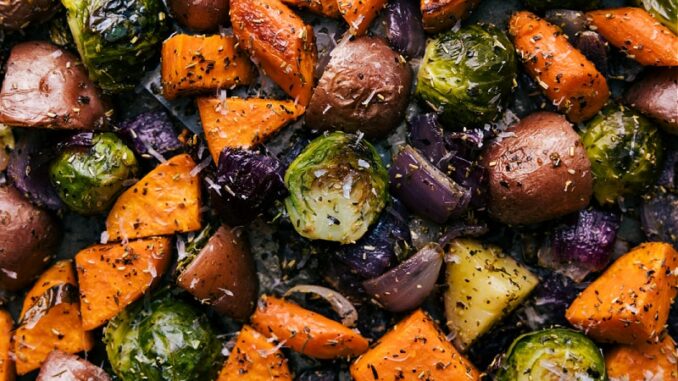
Introduction:
Roasting vegetables is a culinary technique that transforms ordinary produce into savory, caramelized delights bursting with flavor. Whether you’re a seasoned home cook or just starting out, mastering the art of roasting vegetables can elevate your meals to new heights. In this comprehensive guide, we will explore everything you need to know to roast vegetables to perfection, from ingredient selection and preparation to cooking techniques and flavor enhancements.
Selecting the Right Vegetables:
Before diving into the roasting process, it’s essential to choose the right vegetables for optimal flavor and texture. While almost any vegetable can be roasted, some varieties are particularly well-suited to this cooking method. Here are some popular options:
- Root Vegetables: Root vegetables like potatoes, carrots, parsnips, and beets are excellent candidates for roasting due to their hearty texture and natural sweetness.
- Cruciferous Vegetables: Cruciferous vegetables such as broccoli, cauliflower, Brussels sprouts, and cabbage develop a delicious caramelized exterior when roasted, complementing their earthy flavor.
- Squash and Pumpkin: Varieties like butternut squash, acorn squash, and pumpkin roast beautifully, with their tender flesh taking on a rich, sweet flavor.
- Alliums: Onions, garlic, shallots, and leeks add depth and complexity to roasted dishes, imparting a sweet and savory flavor profile.
- Bell Peppers and Eggplant: These colorful vegetables become tender and sweet when roasted, making them perfect for adding to salads, sandwiches, or pasta dishes.
Preparing the Vegetables:
Proper preparation is key to achieving perfect results when roasting vegetables. Follow these steps to prepare your vegetables for roasting:
- Wash and Dry: Thoroughly wash the vegetables under cold running water to remove any dirt or debris. Pat them dry with a clean kitchen towel or paper towels to ensure even cooking.
- Trim and Cut: Trim off any stems, tops, or tough ends from the vegetables, then cut them into uniform pieces for even cooking. Aim for bite-sized pieces that are similar in size to promote even caramelization.
- Season: Toss the prepared vegetables with olive oil, salt, and pepper to coat evenly. You can also add additional seasonings like herbs, spices, or garlic powder to enhance the flavor.
- Arrange on a Baking Sheet: Spread the seasoned vegetables in a single layer on a rimmed baking sheet lined with parchment paper or aluminum foil. Avoid overcrowding the pan, as this can lead to steaming rather than roasting.
- Preheat the Oven: Preheat your oven to the appropriate temperature according to the recipe or vegetable being roasted. A high temperature, typically between 400°F and 425°F (200°C to 220°C), is ideal for achieving caramelization and crispiness.
Roasting Techniques:
Once your vegetables are prepared and seasoned, it’s time to roast them to perfection. Here are two popular roasting techniques:
- Standard Roasting: Place the baking sheet of prepared vegetables in the preheated oven and roast until tender and caramelized, stirring occasionally for even cooking. The cooking time will vary depending on the type and size of the vegetables, typically ranging from 20 to 45 minutes.
- High-Heat Roasting: For even more intense caramelization and flavor development, you can use the high-heat roasting method. Start by preheating your oven to 450°F (230°C) or higher, then roast the vegetables for a shorter period of time, usually around 15 to 25 minutes. Keep a close eye on the vegetables to prevent burning.
Flavor Enhancements:
While roasted vegetables are delicious on their own, you can take them to the next level with a few simple flavor enhancements:
- Balsamic Glaze: Drizzle roasted vegetables with balsamic glaze before serving for a tangy-sweet finish.
- Fresh Herbs: Sprinkle freshly chopped herbs like parsley, cilantro, or thyme over the roasted vegetables for added freshness and aroma.
- Citrus Zest: Grate lemon, lime, or orange zest over the roasted vegetables to brighten the flavors and add a pop of citrus.
- Parmesan Cheese: Toss roasted vegetables with grated Parmesan cheese for a salty, nutty flavor boost.
- Toasted Nuts: Sprinkle toasted nuts like almonds, walnuts, or pine nuts over the roasted vegetables for added crunch and richness.
Conclusion:
Roasting vegetables is a simple yet transformative cooking technique that can elevate any meal. By selecting the right vegetables, preparing them properly, and using the right roasting techniques, you can unlock maximum flavor and texture in every bite. Experiment with different seasonings, herbs, and flavor enhancements to customize your roasted vegetable creations and discover your own favorite combinations. With a little practice and creativity, you’ll be roasting vegetables like a pro in no time.